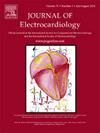Mobile health apps for QT interval measurement: A systematic review
IF 1.3
4区 医学
Q3 CARDIAC & CARDIOVASCULAR SYSTEMS
引用次数: 0
Abstract
Background
The QT interval, which reflects ventricular electrical activity, is a key marker for assessing the risk of life-threatening ventricular arrhythmias and sudden cardiac death. Mobile health applications (mHAs) have recently been developed to facilitate QTc measurement; however, these apps show considerable variation in quality and functionality, and many need clinical validation.
Methods
We conducted a systematic review and evaluated QTc-focused mHAs across Apple iOS, Google Play, and Microsoft Store. Eligible apps that incorporated validated QTc correction formulas, such as Bazett, Fridericia, or Framingham, were available in English or Spanish. Quality and functionality were assessed using the Mobile App Rating Scale (MARS) and IMS criteria.
Results
Of the 88 initially identified apps, 12 met the inclusion criteria. The highest MARS and functionality scores were achieved by “EP QTc by EP Studios,” noted for its range of QTc correction formulas, followed by “QTc-Calculator by Marian Stiehler.” Overall, apps showed significant variability in quality, indicating a lack of standardized features across platforms.
Conclusion
This review highlights the variability in QTc-focused mHAs and the need for rigorous evaluation. Although these apps could enhance arrhythmia monitoring, few meet the standards necessary for clinical practice, emphasizing the importance of validation before integration into healthcare settings.
QT间期测量的移动健康应用程序:系统回顾
QT间期反映心室电活动,是评估危及生命的室性心律失常和心源性猝死风险的关键指标。最近开发了移动卫生应用程序(mHAs),以促进QTc的测量;然而,这些应用程序在质量和功能上表现出相当大的差异,许多应用程序需要临床验证。方法:我们对苹果iOS、bb0 Play和微软商店中以qtc为重点的mha进行了系统回顾和评估。符合条件的应用程序包含经过验证的QTc校正公式,如Bazett、Fridericia或Framingham,有英语或西班牙语版本。使用移动应用评级量表(MARS)和IMS标准对质量和功能进行评估。结果在最初确定的88个应用程序中,有12个符合纳入标准。MARS和功能性得分最高的是“EP工作室的EP QTc”,以其QTc校正公式的范围而闻名,其次是“Marian Stiehler的QTc计算器”。总的来说,应用程序在质量上表现出很大的差异,这表明缺乏跨平台的标准化功能。结论本综述强调了以qtc为中心的mHAs的可变性和严格评估的必要性。尽管这些应用程序可以增强心律失常监测,但很少达到临床实践所需的标准,强调了在整合到医疗保健设置之前验证的重要性。
本文章由计算机程序翻译,如有差异,请以英文原文为准。
求助全文
约1分钟内获得全文
求助全文
来源期刊

Journal of electrocardiology
医学-心血管系统
CiteScore
2.70
自引率
7.70%
发文量
152
审稿时长
38 days
期刊介绍:
The Journal of Electrocardiology is devoted exclusively to clinical and experimental studies of the electrical activities of the heart. It seeks to contribute significantly to the accuracy of diagnosis and prognosis and the effective treatment, prevention, or delay of heart disease. Editorial contents include electrocardiography, vectorcardiography, arrhythmias, membrane action potential, cardiac pacing, monitoring defibrillation, instrumentation, drug effects, and computer applications.
 求助内容:
求助内容: 应助结果提醒方式:
应助结果提醒方式:


